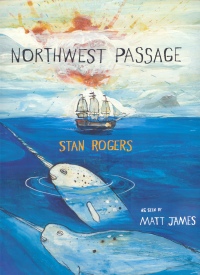| ________________
CM . . .
. Volume XX Number 6. . . .October 11, 2013
excerpt:
Based on the song, “Northwest Passage”, written in 1981 by Maritime folk musician Stan Rogers, this book not only tells the story of the explorers who attempted to find the route to the Pacific through the Arctic Ocean, but it also chronicles Rogers’ own road trip which he took in order to better understand the arduousness of the explorers’ journeys. The song lyrics are interspersed among the descriptions of the various expeditions through the Passage. These lyrics are printed in a very casual font which is different from the more formal font of the factual pages. Near the beginning of the book is a timeline which begins with the arrival of the first Arctic peoples around 6000 BCE and ends in 2012 with the lowest recorded ice levels in the Passage. In this section, the print is extremely tiny, with a lot of text in a small amount of space. Much of the book is devoted to the story of John Franklin whose ill-fated expedition with two ships and 134 men was affected by forces of nature, starvation and disease. Other explorers, such as Alexander Mackenzie and Henry Kelsey, fared better, mainly because they relied on the advice given to them by the First Nations people. The last few pages of the book include the lyrics and sheet music to Rogers’ original song as well as a double-page spread which highlights several explorers - Simon Fraser, George Vancouver, and Roald Amundsen, to name a few- as well as the contributions of the voyageurs and the Hudson’s Bay Company to the exploration of northern Canada. Though the target audience will not likely have heard of Stan Rogers, the words of his song, full of passion and feelings of wanderlust and melancholy, are sure to inspire them. They clearly demonstrate Rogers’ admiration for the bravery of the early explorers and his understanding of their zeal.
But in Matt James’ attempts to pay homage to both Rogers and the explorers, the book becomes just too ambitious. It would have been better if it had been comprised of just the lyrics of Rogers’ song and, perhaps, a bit of background information or the “Gallery of Explorers” at the end. The inclusion of a timeline, narrative about various expeditions, and the focus, changing from Franklin to others and then back to Franklin again, is rather disjointed, interrupts the flow, and takes away from the strength of the original song which inspired the book in the first place.
Recommended. Gail Hamilton is a former teacher-librarian in Winnipeg, MB.
To comment
on this title or this review, send mail to cm@umanitoba.ca.
Copyright © the Manitoba Library Association. Reproduction for personal
use is permitted only if this copyright notice is maintained. Any
other reproduction is prohibited without permission.
NEXT REVIEW |
TABLE OF CONTENTS FOR THIS ISSUE
- October 11, 2013.
AUTHORS |
TITLES |
MEDIA REVIEWS |
PROFILES |
BACK ISSUES |
SEARCH |
CMARCHIVE |
HOME |

 James does an admirable job of showcasing the Arctic and the animals- narwhals, polar bears, arctic hares, to name a few- that call it home. His larger illustrations are more successful than his smaller ones, but his considerable talent is most evident.
James does an admirable job of showcasing the Arctic and the animals- narwhals, polar bears, arctic hares, to name a few- that call it home. His larger illustrations are more successful than his smaller ones, but his considerable talent is most evident.